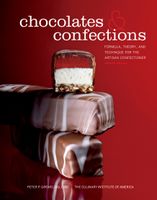Advertisement
Toffee and Caramels
By Peter Greweling and Culinary Institute of America
Published 2007
The difference between toffee and caramels is a gray area that depends largely on the authority consulted. For the purposes of this book, toffee refers to hard caramels that contain dairy products, and caramels refer to chewy caramel-flavored confections—and should not be confused with caramel, which is sugar heated until it melts and turns brown. The similarities between toffee and caramels are greater than their differences. Each contains sugar, glucose syrup, a dairy product, and fat, although the exact percentages of each vary somewhat between the two; other flavorings are optional. Both caramels and toffee derive their flavor from Maillard browning of the protein in the dairy product and from the reducing sugars found in the glucose syrup and the dairy product. The major difference between toffee and caramels is water content, which is determined by the temperature to which the confection is cooked. Since toffee is cooked to a significantly higher temperature, it contains less water, browns more, and has a much harder texture. The reverse is true for caramels; they are cooked to a lower temperature and therefore contain more water and have a softer texture. They also exhibit less Maillard browning due to their lower cooking temperature.

